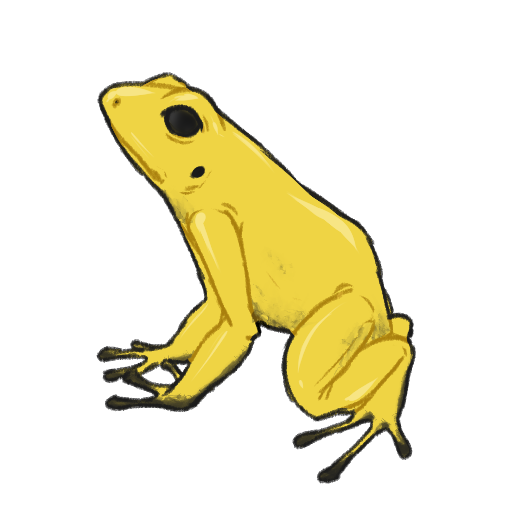Golden Poison Frog (Dart Frog)
Golden Poison Frog (Golden Dart Frog)
Scientific Name: Phyllobates terribilis
The golden dart frog is one of the many endangered dart frog species. The golden poison frog or dart frog is found in a very small part of the Colombian rainforest along the Cauca department on the pacific coast. Often no bigger than a paperclip (or one inch roughly), it's considered one of the larger dart frog species. It is also one of the most toxic dart frogs on the planet. Their poison is strong enough to kill 10 full-grown adult humans, just two salt grains worth of poison is enough to kill a person! These frogs live on the ground and out in the open. Due to their bright color, predators tend to stay away as it's a universal sign of "Stop, I'm toxic!". Females will even lay their eggs right on the ground, where the males will then take the larval tadpoles to a water source to further grow. Their life span is often around 10 years in a prime environment. A group of dart frogs is also called an Army!
These frogs, while typically yellow, can be brightly colored in various yellows, oranges, and sometimes pale greens with a hint of metallic gleam to their skin. The younger frogs are black with two yellow bands down their backs. These color differences are called "Morphs". Their diet consists of smaller insects such as crickets, beetles, and other bugs. This is also where scientists assume their poison comes from. The insects eat toxic plants and pass on those toxins to the frogs. Their poison is also used by the indigenous peoples of the area, tipping darts to hunt with. Taking a live frog, they rub the dart along its back and release the animal alive and unharmed after. Once dry, the poison remains active on the dart for upwards of a year. (Their poison is only secreted through their skin, as they have no other way to deliver it to predators.) The type of toxin they have is called Batrachotoxin, which affects the nerve cells of the body and causes muscles to stay in a contracted state that can lead to heart failure and death. These frogs have modified cells that are not affected by the toxins. Even just touching a frog could be very dangerous to your health!
While it's hard to know their true numbers left, they are endangered due to loss of habitat. Along with so many rainforests, the destruction to make room for crops and grazing land is the main culprit along with lumber production. Some species are also losing numbers because of illegal poaching for the pet trade, though due to ethical breeders that sell frogs legally, it's becoming less common. (Interesting fact, frogs bred within the pet trade are not toxic due to their diet!) There is now an area set up to safeguard their habitat, that is patrolled by rangers. Before, there was no protection for them until 2012 when the land trust was set up to provide a protected environment.
References
https://en.wikipedia.org/wiki/Golden_poison_frog
https://www.nationalgeographic.com/animals/amphibians/facts/golden-poison-frog
https://www.worldlandtrust.org/species/amphibians/golden-poison-frog/
Submitted By NorthernMalagon
for Jungle Expedition: Report
・ View Favorites
Submitted: 3 years ago ・
Last Updated: 3 years ago
